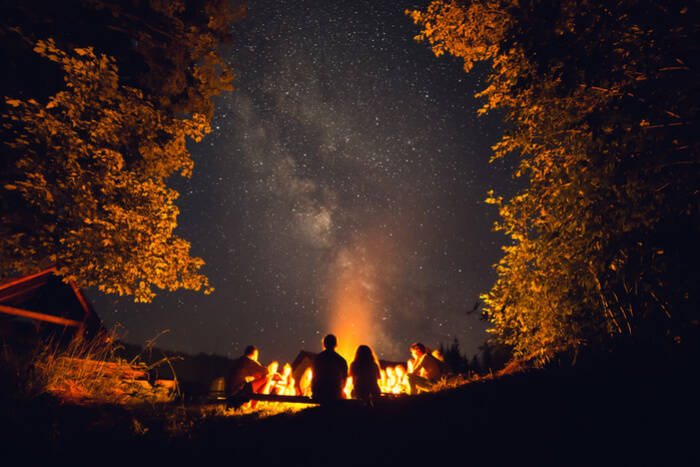It’s that time of year again: Halloween! The leaves and the temperature are falling, the wooden garage is getting decorated, and the ghosts and goblins are creeping. Whether you love or hate this holiday, it’s important to know the history of Halloween. Why? It’s one of the most popular days of the year!

Origins
Halloween can trace its roots back 2,000 years to the ancient Celtic festival of Samhain. This is pronounced sow-in. November 1st was the Celt’s New Year, and the night before, October 31st, was the festival.
What was Samhain?
This festival was on the last day of summer. This also coincided with the last day of the harvest. They Celts were entering the time of the year where darkness and cold took over. A time of the year they associated with death. To be fair, most of the deaths 2,000 years ago probably occurred during the winter.
It was believed that on October 31st the boundary between the living and the dead was blurred. That is, ghosts could and did cross between the worlds at will. Although the Celtic people thought these spirits mostly caused trouble, they also depended upon them. Their priests, called Druids, used the ghosts to make predictions about the future ahead.
What about Costumes?
Yes, even costumes originated from Samhain. However, they were much more frightening back in the day. The costumes the Celts wore were made of animal heads and skins! Another Halloween tradition that came from this festival is bonfires.

For the celebration, priests built humongous bonfires. The people would throw in crops and animals as sacrifices to the otherworldly deities. They believed this gave them the power to tell each other’s fortunes, and attempted to do so.
After the party was over, the Celts re-lit their hearths with fire from the bonfire. They believed this would protect them during the cold, harsh winter months.
The Romans
The Romans conquered just about everything, and Celtic territory is no exception. In fact, they were in charged there for a whole 400 years! During this time, they merged 2 of their festivals with Samhain. These were Feralia and Pomona.
Feralia was also held at the end of October, and also honored the dead. Pomona was the day when the Romans celebrated the goddess of fruit and trees. This explains where the modern day tradition of bobbing for apples originates!
All Souls Day
The Catholics weren’t far behind the Romans, and in 1000 CE the church made an official holiday to honor the dead. They called it All Souls Day, and it’s very likely they were trying to rid the area of its rich cultural traditions in favor of church-sanctioned culture.

All Souls Day was very similar to the original Samhain festival. There were huge bonfires, parades, and even costumes. By this time, the people were dressing up as saints, angels, and devils. This celebration was also called All-hallows or All-hallowmas. Eventually, those in the Celtic regions called it All-Hallows Eve. Finally, it was named Halloween.
Halloween in the USA
The territories were divided in how they celebrated Halloween. Northern New England was extremely religious, so they didn’t partake in the festival like the southern colonies did. The many different customs and cultures of the immigrants, as well as Native Americans, made Halloween what it is today.
In the beginning, it was popular to have play parties. These events were public, and they were a way of celebrating the harvest. During these parties, the community would dance, sing, tell each other’s fortunes, and tell ghost stories. Making mischief was also common.
Halloween only became a staple of the United States of America when they received millions of Irish immigrants.
Irish Influence
It was only after the influx of immigrants that Americans began to dress up in costume and go door-to-door. Children asked for money and candy. Young women tried to see the face or name of their husbands through divination. They used mirrors, apples, and yarn.

Late 19th and Early 20th Centuries
Late in the 1800s, Halloween parties started popping up. Community and neighborhood parties were now more of a focus than the witchcraft, mischief, and ghostly tales. Both adults and children had their own Halloween get-togethers full of food, costumes, and games.
It was also around this time that parents and kids were discouraged from anything frightening and grotesque. Unfortunately, this movement made the holiday lose its superstitious vibe. From there, the festival was decidedly more secular and community-centered.
During the 1920’s trick or treating came back in style. This was due to the ability of almost anyone to be able to partake in giving away candy as community involvement. Families also wanted to avoid tricks being played on them. Around this time, vandalism was making a comeback as a holiday tradition.
History of Masks
The Celtics, and eventually Europeans, believed spirits roamed the Earth on October 31st. They were afraid of running into them, so they wore masks to cover their humanness. The people were hoping to be addressed as a fellow ghost!
History of Trick-or-Treating
For some reason, it became popular to put out bowls of food on Halloween. People thought it would keep the spirits happy enough to stay away from their homes. Most likely, it was just a waste of precious resources.

Why are Black Cats Scary?
This superstitious belief dates back to the Middle Ages. It was during this time when literal witch hunts were going on. People believed witches turned themselves into black cats, and were afraid to cross the witch!
Old Halloween Romance Traditions
This was the time of year when young women thought they could identify their future husbands. There were a few ways a girl could do so. First, she could name hazelnuts after her suitors and throw them in a fire. The nut that burned away was a love that wouldn’t last.
Other times, young women would throw apple peels back over their shoulders in hope they would show a man’s initials. Some stood in a dark room, held a single candle, looked into a mirror, and hoped to see their future lover’s face.




